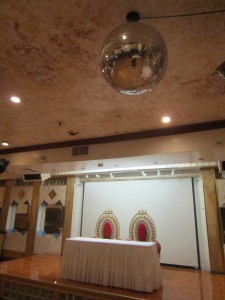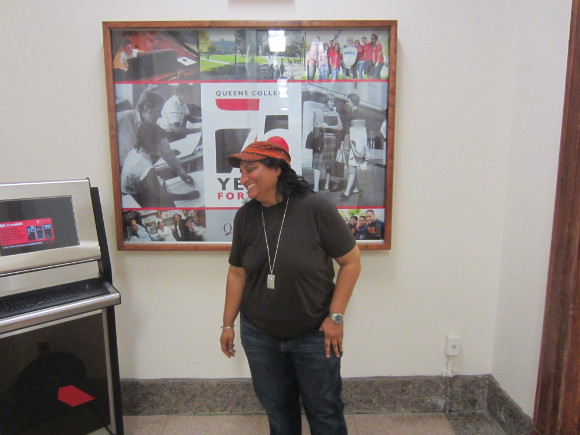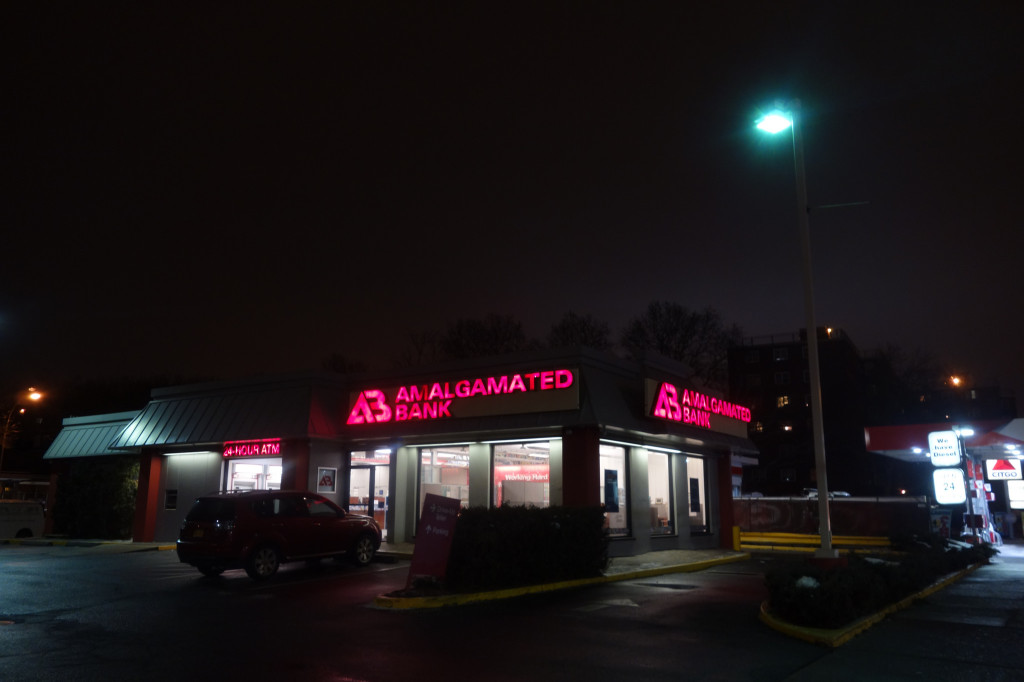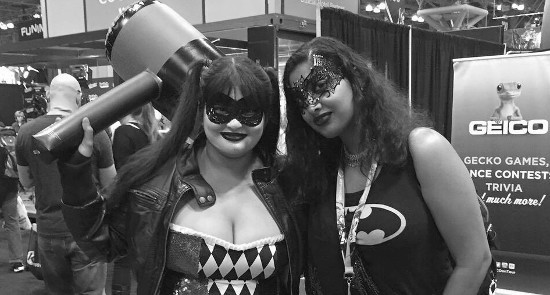The Basement Bhangra deejay revisits the neighborhood of a legendary Hollis nightclub that flourished in the 90s.

January 18, 2013
4:51 p.m.
111th Street J Train Station, Richmond Hill, Queens
A mint square materializes on the screen of my phone, bearing a message.
Cool five stops away.
The text is from Rekha Malhotra—DJ Rekha. It means she is on the J train, nearing Richmond Hill. She is coming from the East Village, where she will soon begin a teaching position in the Clive Davis Institute of Recorded Music at New York University.
Famed for championing bhangra—a unique sound that merges traditional South Asian music with hip-hop—Rekha, one of the most successful South Asian artists in the United States, has even played for President Obama in the White House. She is also a public intellectual. A former artist-in-residence at NYU’s Asian/Pacific/American Institute, she helped produce the award-winning radio documentary Feet In Two Worlds: Immigrants in a Global City and often takes contrarian positions on the issues of popular music and culture. “Identity to me is a shifting idea,” she told CNN in a 2006 profile.
I have invited her to join me for an afternoon in Queens. While her Basement Bhangra and Bollywood Disco parties are embedded in the landscape of Manhattan nightlife, Rekha has deep connections here. Raised mostly in Long Island, she went to Queens College, socializing nearby. In her company I am hoping to absorb some of the cultural history of this community, submerged by time and collective forgetting.
—
I wait about ten minutes until I hear an arriving train squealing and clacking above. Shortly after, she curls out of the stairwell wearing a dark gray tee and orange military-style cap. She stops to survey the street and sees me waving.
Rekha settles into the passenger seat in my car, resting her puffy red courier bag at her feet. I imagine that, in her satchel, between Xeroxed handouts, there is a laptop with a fresh track for her label, Beat Bazaar Music. Their first release—“Pyar Baile”—blended Bollywood with baile funk, an Afro-Brazilian take on Miami Bass; I wonder what the next direction is.
“So what’s the plan?” she asks me. Earlier, we had discussed visiting the location of Soca Paradise, a legendary Hollis nightclub that flourished in the nineties. I suggest we meander through the backstreets on the way there.
She leans forward to read the street signs. “We went to the Gurdwara nearby here when I was a child,” she says. She is referring to the large Sikh temple on 117th Street. “I don’t really know Richmond Hill that well,” she cautions.
—
5:15 p.m.
Punjabi Kabab House, Richmond Hill
On Lefferts Boulevard, we find ourselves in front of Punjabi Kabab House, a favorite Richmond Hill eatery. Something registers. “I remember this place,” she tells me.
“It was about 2000; my friends and I attended the Phagwah festival and then stopped here for food. At the next table two guys had some Johnny Walker Black tucked away on the floor.
One friend, Sanjeev Srivastava, started asking them, ‘Occasion kya hai? Occasion kya hai?’ I was like, ‘Sanjeev—don’t start, please—I just want to go home.’”
The Phagwah parade, or Holi, is an annual religious event celebrating devotion to the deity Lord Vishnu; a mini-Carnival. Young people in white clothes smear one another with colored powder and paint. It is a vibrant and colorful affair. In Richmond Hill the celebrants are primarily Indo-Caribbean; Rekha and her friends were not.
I ask how the different strands of the South Asian diaspora got along. They lived mostly in parallel, she says, offering one example. The Guyanese and Hindu religious shops lining Liberty Avenue with garlands, candles, and figurines were largely unknown to Indians in Long Island.
It was at places like Soca Paradise where intersections happened. “I don’t remember any issues,” she says. “We went everywhere—those were some good days.”
—
5:45 p.m.
Office of Kate K. Chalwa, M.D., Hollis
 Thirty minutes later, we are crossing into Hollis along Hillside Avenue when Rekha has another unexpected memory. “I used to work at a doctor’s office! I think it was near here.”
Thirty minutes later, we are crossing into Hollis along Hillside Avenue when Rekha has another unexpected memory. “I used to work at a doctor’s office! I think it was near here.”
She scours the passing addresses and, after two turns, we find it. The doctor’s office is one of a series of attached row houses and close to where we think we are going next. We decide to go have a look.
“This is awkward. I’m pretty sure I won’t be remembered,” she jokes at the door.
We enter a small room. Rekha approaches the young clerk at the desk. She is a former employee; is Dr. Chalwa available?
“Nothing in here has changed,” Rekha notes. We sit in the back row, away from the television; the attendant returns to transcribing. “That used to be me,” she says, in a low voice. “He’s probably making the same money I was, too.”
A door opens, producing a small Indian woman with short hair and glasses. Her unsmiling face and white coat are authoritative. Rekha stands up; I make myself invisible.
“Hi, I’m Rekha Malhotra. I used to work for you.”
Dr. Chalwa looks at her blankly. “You didn’t work for me.”
Rekha is deferential but insistent. She mentions other details: a private clinic in Long Island, a rental property. The doctor’s eyes widen until—having heard enough—she changes the subject. “So, are you coming here as a patient?”
We leave.
Stepping back outside I recover some adulthood; watching the intractable doctor I had felt myself reverting to a younger, smaller self. Our encounter reminds me that even in a relatively small community, like the Indian-American one in Long Island, different segments can exist in distinct time signatures, one so out-of-sync with the next. Rekha is unperturbed by our brief journey back in time. We laugh and agree: it was just as awkward as she had predicted.
—
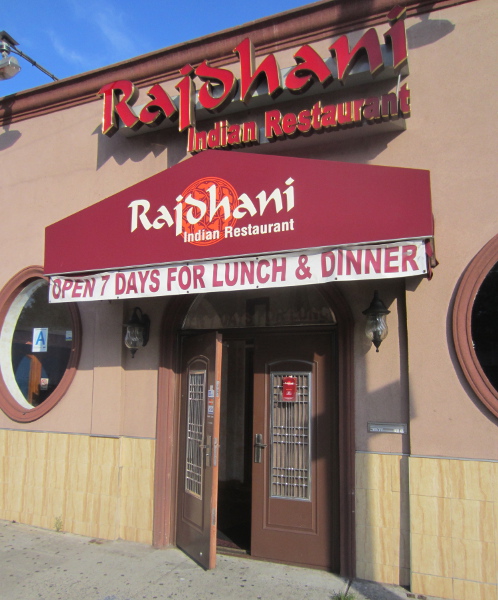
6:05 p.m.
Rajdhani Indian Restaurant, Hollis
A few blocks over on 189th Street and Hillside, we stop in front of Rajdhani Indian Restaurant. We think this was where Soca Paradise lived. According to a 2002 City Limits piece by Corey Takahashi, it was the “first major Indo-Caribbean nightclub in Queens” when it opened in 1989, drawing crowds from as far as Toronto.
Rekha is excited; stories bubble up. The first night she planned to go, she paged her friend to ask the cover charge. The response came, written thrice for emphasis:
12-12-12.
“If there was an Indian party in the city, we’d go. Otherwise, it was Soca Paradise, or Malibu in Long Island for new wave. Two choices; that was it.”
__
Inside, we meet poor lighting and a sour smell. My eyes adjust to an empty room; there are no patrons. Rekha discreetly covers her nose.
A young, wiry server approaches. He smiles and welcomes us, his small, dark eyes shifting back-and-forth.
“Was this a nightclub once?” Rekha asks, friendly-like.
He wasn’t expecting the question. “I believe it was,” he says, after a moment. “I don’t know that much, though.”
“The place is much smaller than I remember,” Rekha says, surveying the room. Two questions later, we discover there is another side to the restaurant. Can we see it?
He leads us into a hall near the kitchen. We pass a wide, descending stairwell and stop at a bolted door. We enter a large, dark ballroom. The lights snap on. “That’s more like it,” Rekha exclaims.
The room is unexpectedly elegant. Blonde wood floors shine; round tables and long-backed chairs are draped with white cloth. “Ah yes. This is where the deejay used to be,” she says, walking to the stage. There, two regal, embroidered wedding chairs face her.
I try to imagine the scene from two decades ago: flowing pants, complicated hairstyles, fine gold jewelry; Hindi lyrics over reverberating reggae bass lines.
“We used to come in from that entrance. And the bar was there.” Her gaze takes me to an empty marble counter. She moves slowly to the center of the hall, studying everything.
“It still feels small,” she says, finally, with a hint of disappointment.
—
We are back in the car, on the move. I ask her what changed; why Indians stopped frequenting Trinidadian and Guyanese clubs in Queens. Her answer is simple: more Indian parties.
By 1996 Indian party culture in Manhattan had taken off—even the New York Times decided to cover it. “A distinctly South Asian youth culture, rooted in hip-hop and Hindi pop, is flourishing in New York City,” wrote Somini Sengupta. The article focused on the scene at Planet 28, a multi-level Chelsea discothèque “packed with young Indians and Pakistanis.”
Rekha booked the first Indian party at Planet 28—when it was called Demerara—although she was not included in the Times piece. “There was an advertisement in the Village Voice, renting space for $500, and a phone number,” she recalls. She called and spoke to the owner. He was Guyanese.
—
6:31 p.m.
Parsons and Kissena Boulevards, Flushing
We drive down Hillside and turn onto Parsons. History pops up everywhere. As a young child, Rekha’s family lived in Flushing; later, from Long Island, she returned to attend Queens College.
She points to some bungalows on the left where friends of family lived. As a small girl she and her mother visited for the daylong Kurva Chauth fasts, broken when the moon became visible. In the evening, she recalls, fondly, the father of the host family “sent me outside to look for the moon.”
Turning onto Kissena Boulevard, we enter into a stretch of one-story delis and grocers. Eventually we wind off of the main road, onto the inclining Queens College driveway. The security guard ignores us. The campus boasts cascades of green, punctuated by an occasional tower.
We park and walk towards the student union. Rekha points out Townsend Harris High School, a square rust-and-grey building. It looks like a police station. Comic Hari Kondabolu, she tells me, went to school there.
The student union is deserted. She notices the cafeteria’s décor has changed; it conjures up a five-and-dime. The basement, however, looks the same. We find the narrow office that the Indian Students Association occupied. She was the group’s president.
However, as an urban studies major, and hailing from ethnically mixed Westbury, Rekha was engaged with issues outside the Indian community. “I remember when Dr. Leonard Jeffries visited,” she says. In a 1991 lecture, Jeffries, a professor of black studies at City College, said that the “Russian Jewry” had invented Hollywood to show “Africans being denigrated.” His comments were picked up by the national media, and sparked a heated debate.
There were tensions, predictably, between Jewish and African-American student groups around his visit then. What about the Indian students? I ask. Most of them, she tells me, were unaware of the controversy.
We move to a much larger, subterranean room, where on-campus dances for the Indian Students Association were held. Here Rekha recalls a popular deejay, Lil Jay. A Forest Hills native, he was getting booked at college parties while still in high school. These days he’s a prime-time mixer on 92.3, going by his given name Jay Dabhi.
Eventually Rekha and her cousins decided to form their own sound system, Sangam Sounds. They bought their equipment piecemeal (in one case off the back of a truck). When her cousins had to leave the country, she kept at it.
Many of her first gigs (like the one at Demerara) were fundraisers for activist groups like Sakhi. In November of 1996, after she deejayed and promoted an unexpectedly successfully event at SOB’s in the West Village, management offered Rekha a chance to hold her own night. Shortly after, Basement Bhangra began. UK fusion producer Bally Sagoo, among the first to blend reggae and Indian music, headlined the first night.
—
At Soca Paradise, Rekha had enjoyed the Jamaican reggae, Afro-Trinidadian soca, and Indo-Trinidadian chutney—but missed the bhangra. “The only song they played was ‘Bolo Tara Rara‘ by Daler Mehndi,” she half-complains. (A 1997 Trinidadian interpolation of the Indian pop hit entitled “Soca Bhangra” remains popular. Rekha, however, was speaking of an earlier version I have not heard, which features vocals by Vicious Arawak on a mixtape by Chicago-based T.S. Soundz.) The fundraisers were limited in other ways: she was often discouraged from playing either hip-hop or bhangra. The organizers feared it would attract “the wrong element.”
Basement Bhangra offered her the opportunity to play the hip-hop, reggae, and bhangra she liked. And it wasn’t Daler Mehndi. “She even prefers a more traditional strain of bhangra that’s heavy on the dhol, a double-sided drum,” her one-time collaborator, writer and filmmaker Vivek Bald, told the New York Times in 2007.
—
7:45 p.m.
Richmond Hill
The sky darkens as we head back to Kaeiteur Restaurant, a popular Guyanese gathering place in Richmond Hill. We sit in the dim back room, where massive paintings of waterfalls and rivers watch over us. Rekha is eager to try something new. The waitress suggests Bunjal Chicken—grilled meat coated in a masala.
I reflect on the clarifying power of memory. Rekha knew an earlier Queens, from more than two decades ago, when South Asians were just beginning to find a foothold.
“I remember when the only desi groceries were in Jackson Heights,” she had told me. As the community developed, artists like Rekha, Jay Dabhi, and Hari Kondabolu emerged. There were exchanges between Indians, Indo-Caribbeans, and others. I had missed these synapses, and from my vantage point noticed only suburban aspiration, and isolation.
The Bunjal chicken arrives. Rekha picks up a piece and chews for a moment. I look for a reaction. But it is not new to her, she already knows it.
“I think my friend’s mom used to make this for us,” she says, smiling and leaning back in her chair. I am not surprised.
—
After we part, I stumble upon a business profile for Soca Paradise Inc. “Status INACTIVE,” it reads, like a coroner’s report. The address given, 205-20 Jamaica Avenue, is strange to me; I look on a map. Rekha and I got the location wrong, and ended up a few blocks away. After fifteen years, the corners of Hollis had eluded us.
But did it matter? That world, I realized, existed now in fragments, in places like Club Jouvay and Maracas Bay. And, at Basement Bhangra. Every month, DJ Rekha–whether through baile funk, Bollywood, or bhangra—mixed old Queens back to life.
—
After 15 years, Basement Bhangra has moved to Le Poisson Rouge. Join DJ Rekha there every first Thursday of the month.


